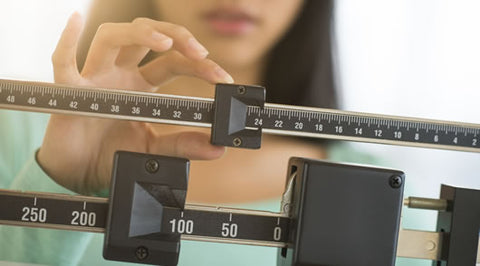You can still pinch an inch (or more) and those scales refuse to budge. You’ve tried everything to lose weight and it seems the harder you work, the less success you have. Countless hours of cardio combined with monastically regimented eating has only made you smaller, and softer. You quit your training program, citing a slow metabolism as the prime culprit in your failure to achieve a symmetrical and proportionately defined physique. Yes, that’s right, a slow metabolism has become the new villain in the fight against fat. Metabolism, the immutable enemy against all things slim and shapely, has again thwarted our fat burning efforts, we conclude. What can we do? Or do we simply give up and eat what we wish, secure in the knowledge that we will forever be cursed with the dreaded Slow Metabolism?
Understanding Our Metabolism

While a sluggish metabolism must take some of the blame for the difficulty we have shifting stored fat, we can, with the right tools, make ours work to our advantage. First of all, far from being immutable (one of many fat loss misconceptions), our metabolism is subject to change. Though hereditary factors do play a role in how fast or slow ours is, we may still influence the extent to which our individual metabolic rate burns excess fat. Involving a complex and constantly interacting network of enzymes and hormones that convert the foods we eat into fuel, and also the rate at which this fuel is utilized, our metabolism determines to a significant degree how fast we lose weight and, depressingly for some, how quickly we gain it.
AGE, HEREDITY, LIFESTYLE, SEX, BODY COMPOSITION, AND, TO A FAR LESSER DEGREE, THYROID PROBLEMS ALL CONSPIRE TO DOWN-REGULATE OUR METABOLISM.
That our metabolic rate slows by 5%-10% per decade after the age of 25 makes fat burning tougher the older we get; genetic influences may also predispose us to a lifetime of strict dieting and cardio-centric training; as well, a fat and simple carbohydrate based diet and a sedentary existence keep our metabolism on par with that of a tree sloth on Prozac; also, men burn more calories at rest than do women and, on a related note, the larger and more muscular we are, the greater our metabolic advantage; finally, a thyroid (the endocrine gland which regulates our metabolism) defect can cause a plunge in our metabolic rate. As you can see, many a variable may make it easier for us to gain weight than to lose it. Even for a seasoned bodybuilder, metabolic fluctuations can, relatively speaking, prove extremely disheartening: the difference between 7% and 10% body-fat being vast when under the unforgiving lights of a contest stage. Whether weekend warrior, gym newbie, or established physique champ we could all do with a little more metabolic elevation.
Increase Your Body’s Need For Energy

The most effective way to boost metabolic efficiency is to increase our body’s need for energy. Sitting around all day (whether rotting away on the couch or at the desk) will not do the job. So we must exercise, but not just any old activity will do. Though all voluntary physical movement will burn calories and is to be encouraged, the best forms include anything that will significantly elevate the heart rate and stimulate the most amount of muscle at one time.
WEIGHT TRAINING AND HIGH INTENSITY CARDIO COMES OUT ON TOP FOR THEIR ENERGY DEMANDS AND THE COVETED ‘AFTER-BURN’ EFFECT WHERE YOUR BODY BURNS FAT UP TO 24 HOURS AFTER INTENSE TRAINING.
Because the body uses a combination of fat, carbohydrate and protein for energy production and the repair of damaged tissues, we must force the body to use more of the former (particularly that which is stored) and less of the latter two: especially that which is stored as muscle tissue. One way to burn more fat than muscle (or to promote a muscle’s ability to generate sufficient training energy) is to keep training sessions short and intense. For example, rather than trudging through six one hour steady state cardio sessions per week, try four 30-minute HIIT sessions instead. Shorter, higher intensity bouts of weight training produce a similar effect, burning fat during and long after, each session.
Eat More & More Often (and Better)

Fitness enthusiasts have for decades reaped significant fat loss benefits from eating 5-6 meals per day comprising plenty of nutrient dense calories. Provided our energy demands are sufficiently high and the majority of calories we consume are from quality nutrients and not loaded with nutritionally useless simple sugars and trans-fatty-acids, our systems will function more efficiently and our furnace-like metabolisms will continue to burn any excess.
A COMMON WEIGHT LOSS MISCONCEPTION DEMANDS THAT IN ORDER TO LOSE WEIGHT WE MUST SLASH OUR CALORIC INTAKE.
For the greatest metabolic advantages, do what bodybuilders and fitness folk have been doing since the first barbell was lifted: consume a daily macronutrient ratio of 15% essential fats (with a small amount of saturated fat for hormone production), 45% complex and fibrous carbohydrates (limit simple sugars and fruit, in particular fruit juices), and 40% High Biological Value (HBV – a measure of the proportion of absorbed proteins we eat) proteins.
Why Such a High Protein Intake?

Most people, upon assessing their protein intake, would discover that their intake of this vital nutrient is extremely low (a paltry 20% of overall caloric intake would be an achievement for these ‘cereal with milk’ for breakfast types). If these people, along with the researchers who advise .5 of a gram of protein per pound of bodyweight (or less!) per day were to open their eyes they would see that, of all the macronutrients, protein is metabolically the most advantageous. Indeed, not only is protein essential for muscle tissue repair (larger muscles promote a superior metabolism) it is also, by comparison to both carbs and fats, a significant metabolic booster. In fact, for every 1000 calories of protein we consume, 300 calories are used for its digestion alone. The intake of protein can also produce a 5%-10% increase in metabolic rate within 8-15 minutes of consumption. You complain of a sluggish metabolism? Have you checked you protein intake lately?
Gain Weight (the Muscle Kind)
As paradoxical as it may sound, the heavier you are, irrespective of whether the weight you hold is primarily muscle or fat, the more efficient your metabolic rate will be. Since the extra weight your body must carry forces your metabolism to work harder at rest (to sustain such an overload) the faster your metabolism will be. When beginning the fat loss process, many larger people will experience a near-immediate decrease in weight; this is because their fuel-injected metabolism is already functioning on all cylinders. However, the lighter these people get, the slower their metabolism becomes until eventually their body, at this stage requiring far fewer calories to function, may actually begin putting the weight back on – the so called yo-yo effect in action.ONE WAY TO AVOID THIS PROBLEM IS TO REPLACE OUR FAT MASS WITH MUSCLE MASS SO WE CAN STAY HEAVIER AND REAP THE ACCOMPANYING METABOLIC INCREASES.While we do not want to maintain any surplus fat, regardless of any beneficial metabolic trade-offs, we do hope to keep our calorie burning at full throttle. By concomitantly gaining muscle as we lose fat, the calorie burning process continues unabated, both during exercise and at rest, as we increasingly become leaner
EACH POUND OF MUSCLE WE MAINTAIN BURNS AROUND 35 CALORIES PER DAY TO SUSTAIN ITSELF, WHEREAS THE SAME AMOUNT OF FAT USES ONLY 2 CALORIES PER DAY.
Being a largely metabolically active tissue, muscle is, to a greater or lesser degree, activated whenever we complete physical tasks (weight training producing the most notable increases). Gaining quality beef also boosts metabolic efficiency. Having more muscle also means you can eat more and gain less of the flabby stuff.
Stay on Top of Your Metabolism
A major contributing factor concerning the degree to which we burn stored calories is our metabolism. Many have cited a sluggish metabolic rate as the reason why they have not successfully completed their physical transformation; they may have committed to a life of mediocre gains because of their ‘genetic’ disadvantage. However, as we have seen, there is much that can be done to improve our metabolic efficiency. Gaining more muscle, eating more of the right foods, more often, and training correctly with higher intensity can, and will, positively change the rate at which your body uses energy and how much of this energy is burned. So get to work incorporating all of the above into your program and get leaner, faster.References
- McArdle, W.,D. Katch, F., I. & Katch, V., L. (1996) Exercise Physiology: Energy, Nutrition and Human Performance (4th ed). Philadelphia: Lea & Febiger.
- Mayo Clinic. Metabolism and Weight Loss: How You Burn Calories. [Online] http://www.mayoclinic.org/metabolism/art-20046508 retrieved on 29.1.14
- Stamos-Kovacs, J. Increase Your Metabolism and Start Losing Fat. WebMD. [Online] http://www.webmd.com/diet/features/increase-your-metabolism-start-losing-fat retrieved on 29.1.14



